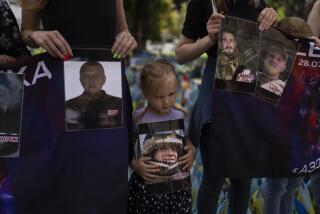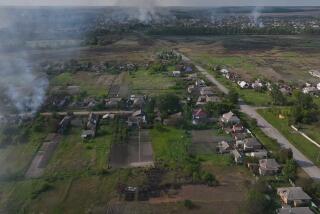Bomb Squad Has Hands Full in Chechnya
- Share via
GROZNY, Russia — The lookout, fortified with bricks and sandbags, is tucked beneath an abandoned house. It has a slit at ground level.
Lying inside is a strip of wood with four ordinary light switches mounted on it. Everyone knows what that means.
“Each of those switches controls a mine,” explains Alexei, one of six elite special forces troops on sapper detail. “The fellow would sit there on those cushions and watch the street. And when someone would come down the road . . .”
He flips the switches, whose wires have been cut. “Boom. Boom. Boom. Boom.”
Three weeks ago, these troops--part of Russia’s elite OMON forces, paramilitary police commandos--were holed up here in Chechnya’s capital just a few hundred yards away, trying to dislodge rebels from this strip of land near the central stadium.
The separatist fighters abandoned the city Feb. 5. Since then, this squad has been making forays into the war zone, trying to clear away mines, booby traps and all forms of live explosives and ammunition.
The work is going on all over Grozny. Explosions can be heard throughout the city, several an hour, more frequently in the afternoon. The massive aerial bombardment that ended earlier this month was far worse. But the continuing blasts are a constant reminder that the war here is not really over, not yet, not until the bombs and shells stop going off. Not until people can walk along the street or into what remains of their homes without fear of losing a limb, or a life.
“It’s still not realistic to start letting masses of people return to the city,” says Maj. Vladimir Zavalishin, military commandant of the Zavodskoy district, where the stadium is located. “The place is still densely mined. There is no water, no food, no gas or electricity. The city is in a coma. It might be possible to revive it someday, but right now it is all but dead--nothing is working.”
First Order Is to Provide Necessities
Russia’s emergencies ministry is concentrating on basic life support for the remaining civilian population, providing hot food, potable water and first aid at a handful of locations around the city. The number of people waiting in line has grown in the last few days, but, Zavalishin says, “One shouldn’t get a false impression.”
“The city is officially closed, and we’re still not letting anyone in,” he says. “There are more people visible on the streets, but that’s because more people keep emerging from their basements and hide-outs.”
It is the Russian Interior Ministry, the OMON squads in particular, that is responsible for the remaining military work--so-called mopping-up operations--which include rooting out any remaining rebels and cleaning up the dangerous detritus of war.
The OMON is a secretive organization that rarely invites public scrutiny. But this brigade has taken the unusual step of inviting a reporter along on its mission, with the understanding that its members will be identified by their first names only.
The cement-block fence along the stadium grounds was one of the rebels’ last lines of defense. Trenches zigzag from under it, cross backyards and furrow beneath houses. Alexei explains that in case a shell lands in a trench, the zigzags will keep it from turning into a fire tunnel. Each house was a fortress, he says, and federal forces fought for them one by one.
“They organized their defenses very professionally,” says Sasha, another squad member. “They did it exactly as it should be done.”
The squad’s two sappers, Andrei and Sergei, call out from where they are working up ahead. They have followed one of the wires and have found the first line. It’s connected to an artillery shell buried a foot under the road and covered with nails.
“It’s very difficult to deal with this kind of mine,” Alexei says. “It’s called a ‘surprise.’ They have probably hidden the second mine under the first, and the second one will go off as soon as you lift off the first.”
The men decide to detonate the mine where it’s buried in the middle of the road. The sappers put a pile of concrete slabs and bricks on top of it and attach a long fuse that they string out down the road. The rest of the party goes 200 yards down the road and takes shelter behind the concrete wall. The squad leader, Dima, reminds the rest to keep their mouths open, to protect against the shock wave.
The blast is massive and sudden, the shock wave slow and just as terrifying. It is a full half a minute before pieces of brick and stone stop falling to earth. At the top of the road there is a cloud of yellowish smoke and a crater 3 feet deep.
The sappers are already following the second wire. It leads into a house on the corner, painted a jaunty yellow. The fence is bright green, a sign of the owner’s support for the Islamic fighters. The Chechen flag is green and black.
The sappers know where to look. They lift some linoleum flooring inside and see a shell lying in a hole cut in the floorboards. A second shell is found in the cellar. The sappers lay them on the ground outside, next to a desiccated grape arbor. They are grayish-green, with bright orange wires trailing onto the dirt. The fourth and last shell is found around the corner, also buried in the middle of the road.
“This is a pretty wide street,” Alexei says. “If one of our tanks came down here, just one of these would be enough to take it out.” The sappers decide also to detonate the fourth shell in place, and the rest of the party heads farther down the street, deeper into the neighborhood. As they pass an open fence, they see a man’s corpse lying in the yard.
Sign of Life Emerges in Zone of Death
Corpses mean trouble. Many are booby-trapped. Dima, the squad leader, radios the corpse’s location to the others.
The second blast is just as loud as the first. As debris rains down, a woman’s voice suddenly calls out hysterically from somewhere nearby: “Don’t shoot us. Please don’t shoot. We’re peaceful civilians.”
The squad members look at one another. It is strange to imagine anyone alive in this death zone. Dima takes off in the direction of the voice and comes back with a large jar of tomato pickles and a 45-year-old Chechen woman.
She says her name is Tamara Khumgayeva. She fled the city in October but returned two days ago to collect what she could from the remains of her house.
“There isn’t much, and what there is is filthy dirty,” she says, her voice now calm. “For some reason, two jars of tomatoes survived. We opened the first one. I’m giving the second one to the boys.
“I’m leaving tomorrow,” she added. “There isn’t another soul around. I’m afraid to stay any longer. There’s nothing left.”
The squad goes back to the dead man. He is lying on his side, curled as if asleep. Andrei the sapper takes out a grappling hook. Everyone stands back as he gently tugs on the body, moving it a few feet. Nothing happens. The squad moves in for a closer look, and then Andrei calls out, “He has no head.”
“What do you mean, he has no head?” Dima asks. “Maybe the dogs ate it.”
Alexei comes down the driveway. “No, it’s a clean cut. Somebody beheaded him.”
The men say they have found a number of headless corpses. Dima says decapitation seems to be what the rebels did to residents who refused to help them. He also speculates that the rebels sometimes keep heads as trophies. The OMON troops admire the rebels’ fighting skills but consider their adversaries moral savages.
Alexei is philosophical. He is vaguely aware that human rights groups have accused Russian soldiers of civilian atrocities during mopping-up operations. The groups say they have documented cases in which troops, including OMON forces, have tossed grenades into basements where civilians were hiding, killing entire families at a go.
But from the OMON point of view, basements are deadly minefields. They are frequently booby-trapped. Before tossing grenades, the squad members call into a basement, Alexei says, to warn anyone hiding inside to come out. It would be foolish to go inside, to risk their own lives for an empty basement.
“You can’t have a war without victims,” he says.
Rebel Graffiti Warns of Judgment Day
The sappers decide to put the two remaining lines they found in the house into the lookout’s bunker--it’s the best-fortified spot in the area. It seems fitting, somehow, to blow up the spot where the lookout lay in wait. This blast is noticeably larger than the first two. Despite the house’s fortifications, the walls and basement cave in.
The squad has had enough. After three hours of such work, the tensions have worn them out. This is the time of day when mistakes get made. On the way out of the neighborhood, the sappers pass by a chalk message written on a fence--one of many the rebels scrawled as they retreated.
“Judgment day is near,” they read. “On this day there will be no dawn. Terror will seize mankind. The horror will strike down even the last child. On that day, the living will envy the dead.”
The sappers shrug their shoulders and say nothing. They head back to their barracks. They don’t have time to think about judgment day. They’ll be back here tomorrow.
*
Alexei V. Kutznetsov of The Times’ Moscow Bureau contributed to this report from Grozny.
More to Read
Sign up for Essential California
The most important California stories and recommendations in your inbox every morning.
You may occasionally receive promotional content from the Los Angeles Times.













